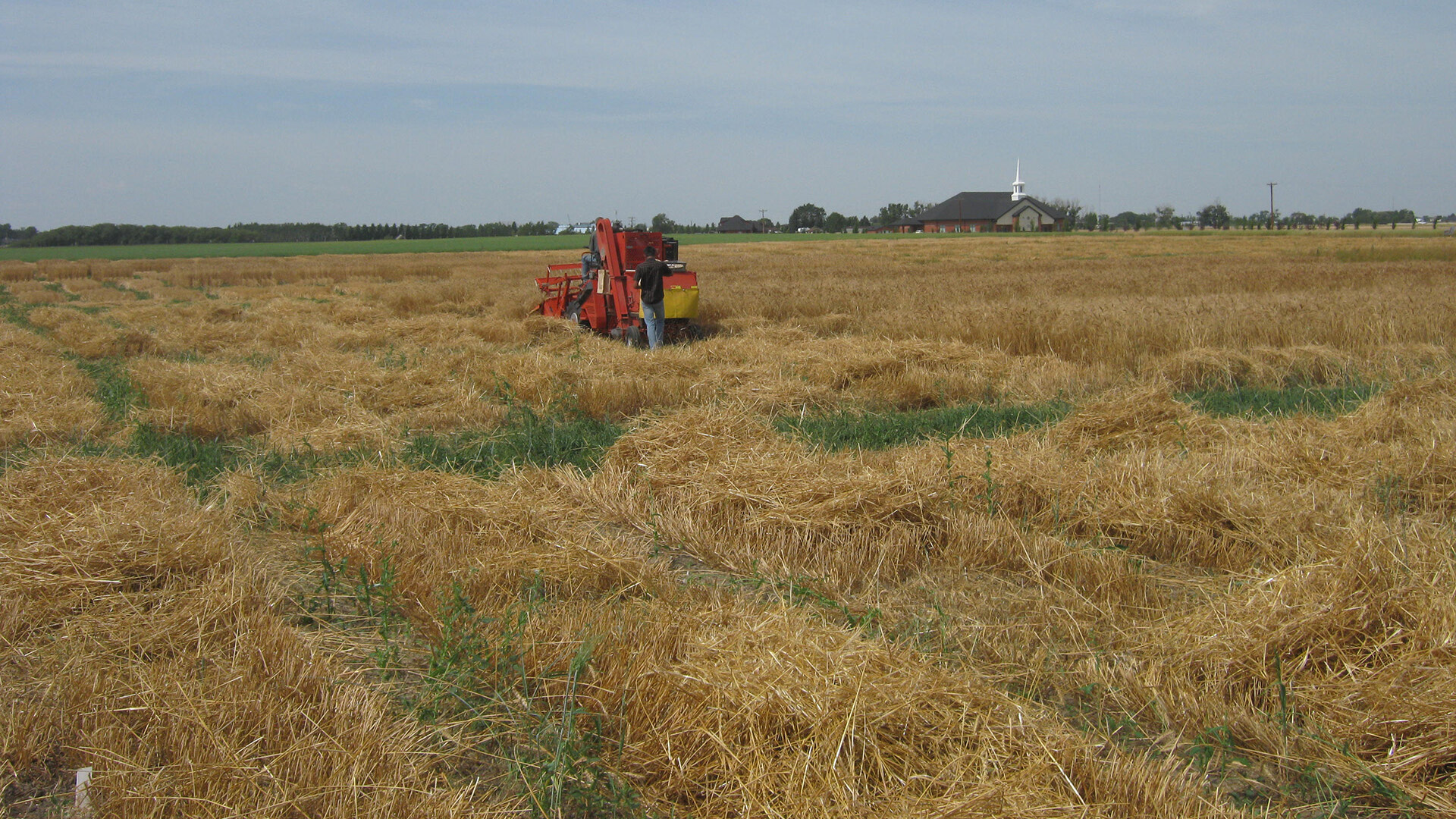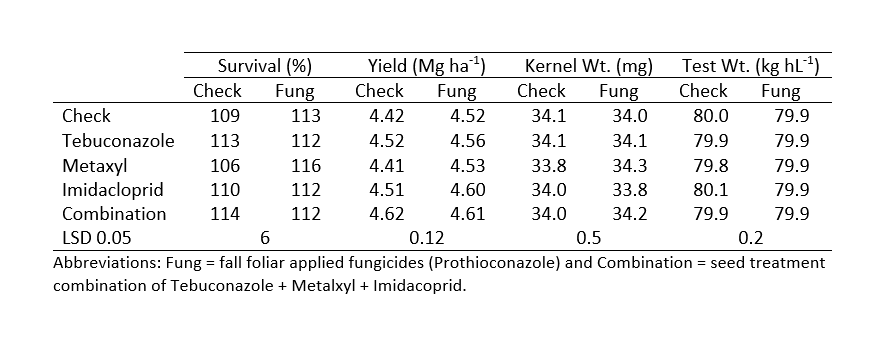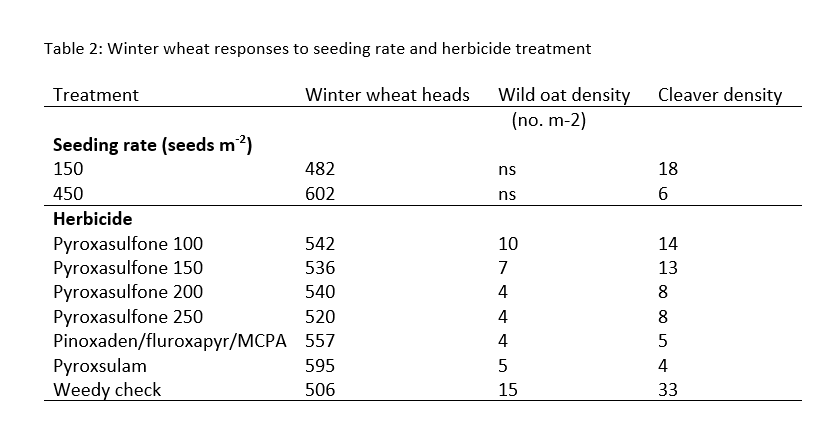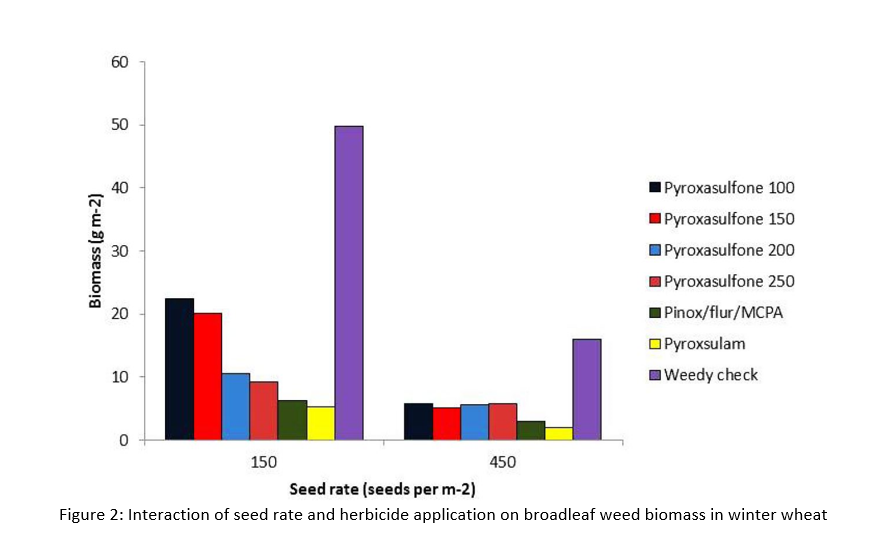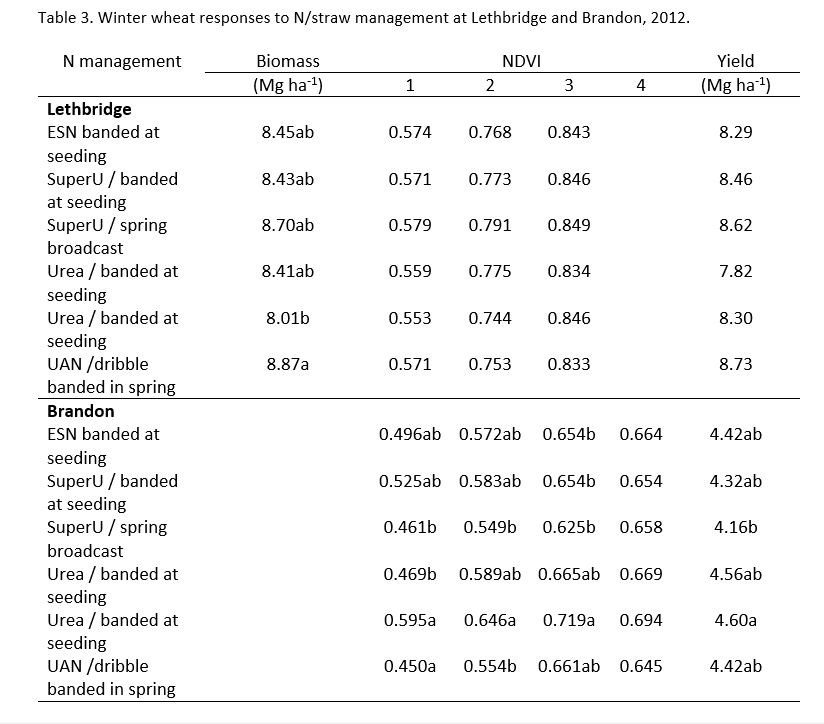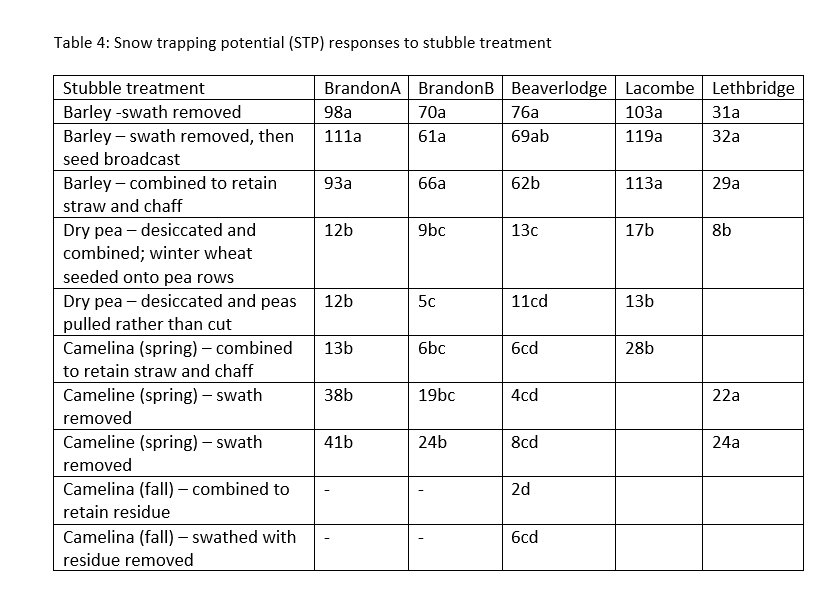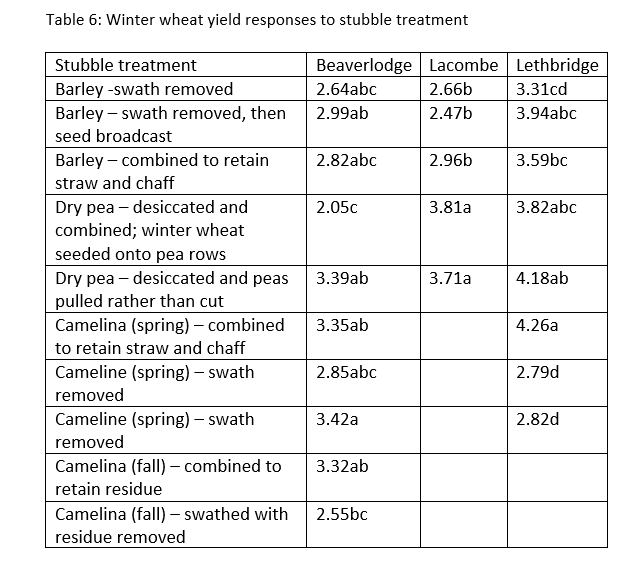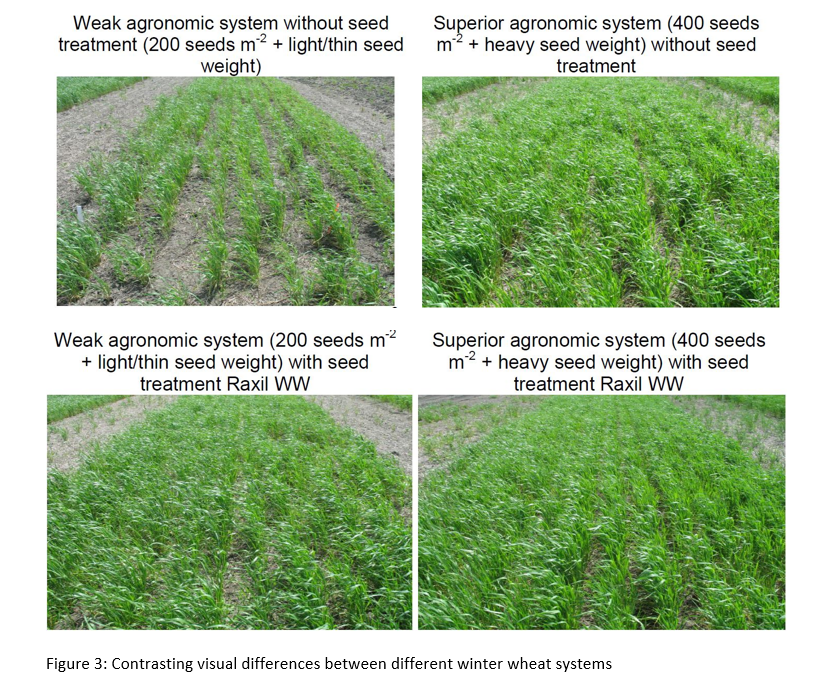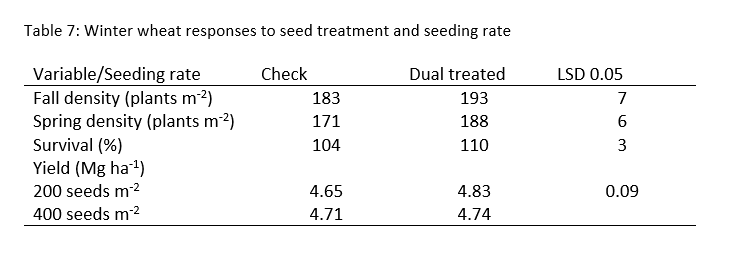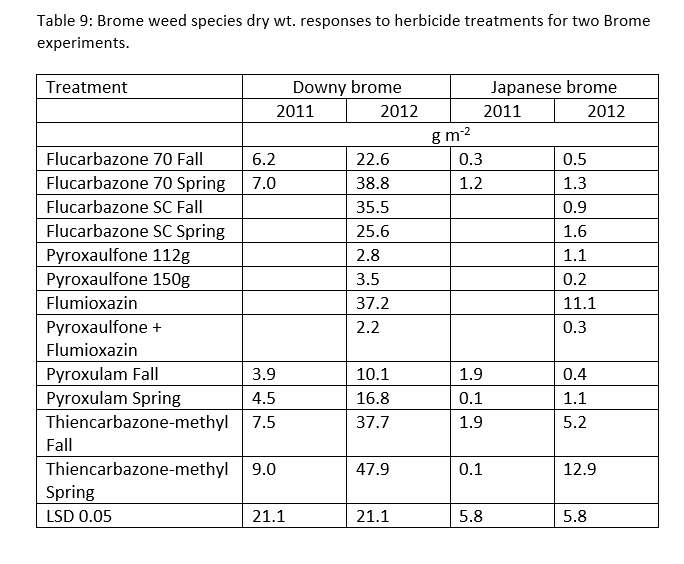BackgroundThe overall objective of this winter wheat research was to overcome obstacles in the adoption of winter wheat in western Canada. A two-fold approach was undertaken towards this objective. First, studies were established to broaden the stubble acreage available late summer for seeding winter wheat. This included using alternate stubble types, managing alternate stubble types, and through the use of seed treatments to expand the amount of stubble available to seed winter wheat into in late summer. Secondly, studies were established to evaluate a number of pest and nutrient management strategies to promote winter wheat plant health, growth and yield stability. Improving these components of winter wheat allow producers to widen the length of the seeding window or seed into less optimum conditions and still realize reasonable success. The overarching theme of the research was the development of improved management practices. Some of the specific activities undertaken as part of this program are described below. |
|
||||||||||
Project Activities
Activity 1 - Determine the influence of seed-applied fungicides and insecticides on fall stand establishment and overwinter survival of winter wheat.A total of 20 sites were established over the course of two growing seasons (2010-2011 and 2011-2012). Plant stand was not affected by the treatments, despite the fact the treatment visibly seemed to have affected winter wheat stand and growth early in the growing season (Figure 1). Grain yield was improved relative to the untreated check when seed was treated with Imidacloprid insecticide or with Tebuconazole + Metalxyl fungicides + Imidacloprid insecticide (Raxil WW). The application of foliar fungicide (Prothioconazole ≥ 'Proline') increased yield slightly to 4.56 Mg ha-1 from 4.50 Mg ha-1 (check). These results are intriguing as it would appear that the fungicide application elicited a favorable plant physiological response even in the absence of symptoms from foliar pathogens (e.g., strip rust at 200-11 sites). Furthermore, contrasts indicated that foliar fungicide positively affected stand survival and kernel wt., and nearly yield only with metalaxyl seed treatment. For test wt., the effect of foliar fungicide was significant only with Imidacloprid.
An examination of the yield and coefficient of variation (CV) of yield showed that metalaxyl seed treatment combinations had lower yield, while treatments including foliar fungicide, Prothioconazole resulted in more stable (lesser CV) yields. The treatment providing the most stable, greater yields was the 'combination' seed treatment with fall-applied foliar fungicide, thus representing one way to stabilize winter wheat production on the Canadian Prairies.
|
||
Activity 2 - Improving weed management in winter wheatWeeds such as wild oat and cleavers can be problematic if winter wheat stands are thin. The objective of this study is to determine the weed control efficacy of pyroxasulfone in managing weeds in optimal and sub-optimal stands of winter wheat. The study was conducted at five locations in Manitoba, Saskatchewan, and Alberta in 2012. Pyroxasulfone was applied pre-seed at rates of 100, 150, 200, and 250 g ai ha-1 to winter wheat seeded at 450 (optimal stand) seeds m-2 and 150 (sub-optimal stand) seeds m-2. Pyroxasulfone weed control efficacy was compared to two post-emergence commercial standards. Herbicide application did not affect plant density indicating that pyroxasulfone did not affect emergence. Visual tolerance of winter wheat to pyroxasulfone was generally low and considered acceptable. Pyroxsulam application resulted in the highest number of heads m-2 (Table 2). It is speculated that spring pyroxsulam application may have resulted in some crop injury; thus, reducing apical dominance; an effect periodically observed with ALS inhibitor herbicides.
Seeding rate had no effect on wild oat density and pyroxasulfone often reduced wild oat density at rates ≥ 150 g ai ha-1 across all locations. An optimal winter wheat stand had lesser wild oat biomass than the sub-optimal stand and all herbicides resulted in lower wild oat biomass than the untreated check only at the location (Lacombe) with greatest wild oat density (results not shown). A pyroxasulfone rate ≥ 150 g ai ha-1 reduced cleavers density at the location (Lacombe) where it was notably present (results not shown). An optimal stand (seed rate of 450 seeds m-2) resulted in a reduction in the pyroxasulfone rate required to reduce broadleaf weed biomass to levels similar to the commercial herbicide standards (Figure 2). Winter wheat yield increased by 5% (4.85 to 5.10 Mg ha-1) when seeding rate was increased from 150 to 450 seeds m-2. Herbicide treatment did not affect yield due to low weed densities and the competitiveness of winter wheat. Results from one year of data indicated integrated benefits of spring winter plant populations exceeding 250 plants m-2 along with soil-applied pyroxasulfone to optimizing broadleaf weed control.
|
|||
Activity 3 - Managing nitrogen when planting winter wheat on barley grain stubble
The major focus of this sub-activity was to determine if nitrogen management recommendations need to be altered when planting winter wheat into barley stubble. There is some concern that heavy trash left after barley is harvested could lead to N immobilization and cause deficiencies in winter wheat. This study was established at Brandon, and at locations in northern (Fahler) and southern (Lethbridge) Alberta in the fall of 2011. Treatments consisted of a factorial combination of four N rates (0, 40, 80, 120 kg N ha-1) and six N application/straw treatments (urea banded at seeding, straw on surface; urea banded at seeding, straw removed; ESN banded at seeding, straw on surface; SuperU banded at seeding, straw on surface; UAN dribble band in spring, straw on surface; SuperU broadcast in spring, straw on surface). N fertilizer rate increased most winter wheat responses, the exceptions being plant density, and kernel/test wt. Of more interest was N/straw management and interactions between the two N management responses. No significant interactions were evident between N fertilizer rate and N/straw treatment for any of the winter wheat responses. Nitrogen/straw management alone did impact some winter wheat responses. Nitrogen/straw management did not affect plant density, grain quality, and N uptake responses. Midseason biomass yield at Lethbridge was greater when UAN was dribble banded in spring (with barley residue on soil surface) relative to when urea was banded at seeding (barley residue removed); biomass yield was intermediate for the remaining treatments (Table 3). Greenseeker assessments of winter wheat growth in May and June showed that NDVI was affected by N/straw treatment only for the initial three assessments at Brandon. The consistent difference that emerged was that urea banded at seeding (residue removed) consistently resulted in an NDVI equivalent to or greater than other N/straw treatments (Table 3). At Brandon, grain yield was greater where urea was banded at seeding (residue removed) than where SuperU was spring broadcast (with residue applied in the spring) (Table 3). This followed the same general trend as NDVI values observed earlier in the season, suggesting that under the relatively dry conditions experienced in fall 2011 in Manitoba, urea banded at seeding (with residue removed) was more effective than spring broadcast SuperU (with residue applied in the spring) and as effective as the other N/straw treatments employed in this study. The extent to which spring-application of straw may have impacted the plant available N supply in this treatment is unclear. No differences were evident between the spring broadcast SuperU treatment, and the remaining N/straw management treatments at Brandon, and for all treatments at Lethbridge.
|
||
Activity 4 - Crop growth enhancement through improved residue management strategies
Crop residue management is critical to successful winter wheat production on the Canadian prairies because it controls snow cover, which ultimately protects winter wheat from winterkill. The suitability of different stubble types for winter wheat is determined by the efficacy of stubble in trapping snow and the availability of stubble relative to the narrow window in which winter wheat can be seeded. Field studies were conducted to assess the direct and indirect impacts of surface crop residues from a wide range of crops on the growth, development, yield and quality of winter wheat. The experiment was established at locations In Manitoba and Alberta in 2010 (2011 for one location near Brandon, MB). The stubble-establishment (1st) year treatments included: barley (swath removed); barley (swath removed, barley seeds broadcast at a rate of 400 seeds m-2); barley (combined to retain straw and chaff); canola (swathed and combined to retain straw and chaff); dry pea (desiccated and combined, with winter wheat seeded between stubble rows of the cereal preceding the pea crop); dry pea (desiccated and peas pulled rather than cut, with winter wheat seeded between stubble rows of the cereal crop preceding the pea crop); spring-seeded camelina (combined to retain straw and chaff); spring-seeded camelina (swath removed); fall-seeded camelina (combined with straw and chaff retained); and fall-seeded camelina (swathed with residue removed). Camelina treatments were not included at all locations. Winter wheat was seeded into the various stubble treatments in the fall of the establishment year. The snow trapping potential (STP stubble height in cm x stubble stems per square meter) / 100) of barley was considerably > 20 (considered adequate) whereas STP for canola or pea was consistently < 20 regardless of the residue management practices employed (Table 4). Spring camelina inconsistently resulted in STP that was adequate, but levels of STP were not as high as barley. Seeding winter wheat after canola reduced winter wheat stands compared to seeding winter wheat after barley, pea or spring-seeded camelina at 2 of 3 locations (Table 5). It is likely that stand reductions for canola stubble contributed to the lesser winter wheat yields for canola stubble at Beaverlodge (Table 6). Seeding winter wheat after pea, but between the stubble rows from the cereal crop preceding the pea crop, resulted in similar winter wheat stands and greater grain yields than seeding winter wheat after barley at all locations. Estimated grain N uptake was greater for winter wheat after pea than after barley suggesting that differences in available N supply may have contributed in part to observed yield differences.
|
||||
Activity 5 - The interaction of seed treatments and fall-applied foliar fungicides on winter hardiness and plant health of winter wheatThis sub-activity explored seed treatment effects in winter wheat similar to activity 1. We also introduced seed size, a proxy for seed vigour, and 2 levels of seeding rate (200 or 400 seeds m-2) as factors in this study. Consequently, we ended up with a range of agronomic systems from weak (low seed rate, small/thin seed, no seed protection) to superior (high seed rate, heavy/plump seed, dual seed treatment). As with activity 1, treatments visibly affected winter wheat stand and growth early in the growing season (Figure 3). Results showed that winter wheat seed that included a dual (fungicide + insecticide) treatment improved plant stand, winter survival and yield. Furthermore, the positive effect of seed treatment for yield was significant only for the least seeding rate. Comparison of grain yield and coefficient of variation for different treatments showed three main groupings of treatments. The first group was a dense group of 400 seeds m-2 treatments that produced average, stable yields and the second group was the seed treated 200 seeds m-2 treatments resulting in greater, but less stable yields. The most inferior group (lesser average yield and greater variability) was the 200 seeds m-2 treatments without seed treatment, particularly the treatments with inferior seed quality (moderate and thin seeds). The results of activity 1 and 5 showed that seed treatments enhanced winter wheat productivity, particularly if the agronomic system is compromised with less than desirable seed lots, thinner plant stands, or perhaps other components not assessed in this study.
|
|||
Activity 6 - The interaction of herbicide selection and timing of application on suppression of Japanese and downy brome in winter wheatDowny brome had shown resurgence, and a new species, Japanese brome, had established in southern Alberta, and spread to other southern regions of the Canadian Prairies. We were interested to see if winter wheat would respond to timing (fall vs. spring applications) and herbicide chemistry (4 registered and 2 unregistered) at all three locations in 2011 and 2012. Winter wheat expressed good visual tolerance to the pre-seed and post-emergent applications for both experiments; average crop injury did not exceed 15%. Biplots indicated that spring-applied Flucarbazone, Pyroxulam, and Thiencarbazone-methyl, and fall-applied Thiencarbazone-methyl provided consistently lesser winter wheat injury. Final visual control ratings (Table 8) and biomass data (Table 9) demonstrated that all herbicide treatments resulted in good to excellent control of Japanese brome. Final visual control rating was greater (near to 100%) and corresponding growth (dry wt.) was lesser for Downy and Japanese brome controlled with the unregistered, pre-plant chemistries, flumioxazin and pyroxasulfone. However, addition of flumioxazin to pyroxasulfone did not improve Japanese or downy brome control compared to pyoxasulfone alone.
Pre-plant chemistries, and to a lesser extent select spring-applied Flucarbazone and Thiencarbazone-methyl treatments, resulted in consistently greater yields, with the clear exception of Pyroxasulfone + Flumioxazin as this treatment provided consistently lower yield, thus indicating that there may be an antagonistic grain yield response when winter wheat is treated with the pre-plant tank mix of Pyroxasulfone + Flumioxazin. With a few exceptions, the fall-applied post-emergent treatments had lesser and more variable yields. |
|||
Project Playlist
|
||

